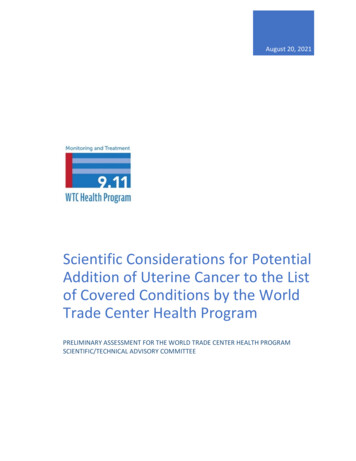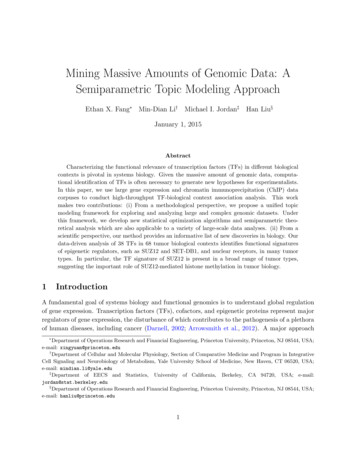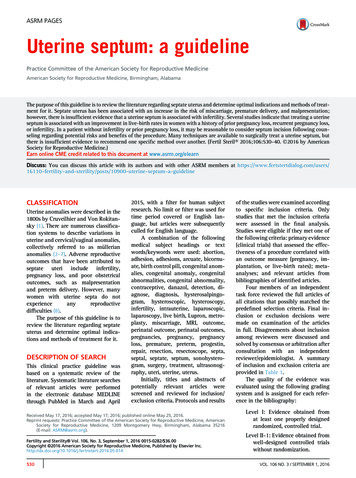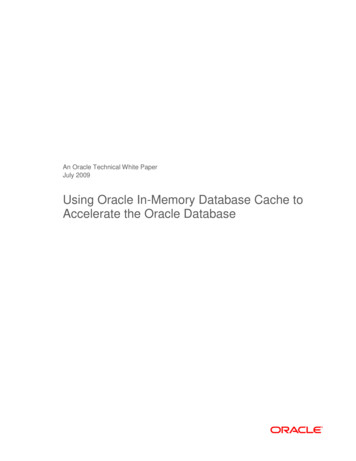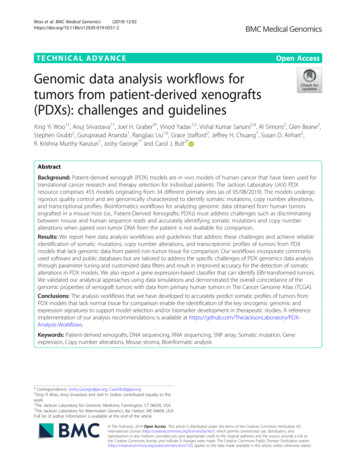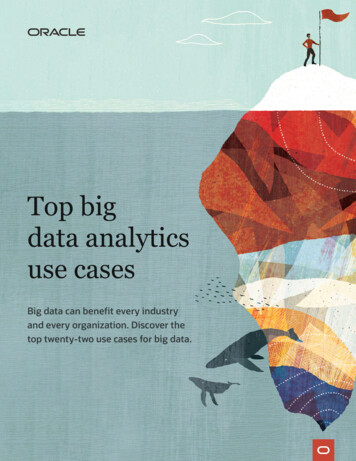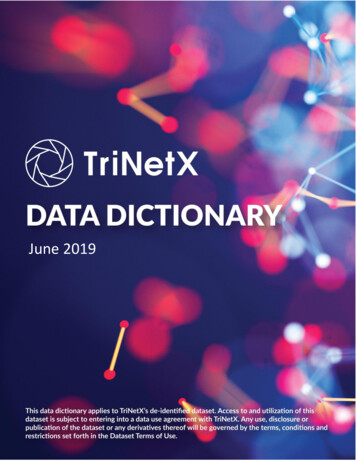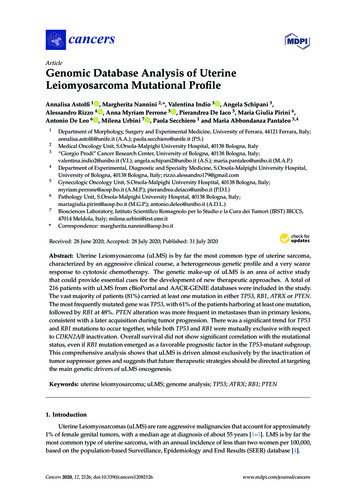
Transcription
cancersArticleGenomic Database Analysis of UterineLeiomyosarcoma Mutational ProfileAnnalisa Astolfi 1 , Margherita Nannini 2, *, Valentina Indio 3 , Angela Schipani 3 ,Alessandro Rizzo 4 , Anna Myriam Perrone 5 , Pierandrea De Iaco 5 , Maria Giulia Pirini 6 ,Antonio De Leo 6 , Milena Urbini 7 , Paola Secchiero 1 and Maria Abbondanza Pantaleo 3,41234567*Department of Morphology, Surgery and Experimental Medicine, University of Ferrara, 44121 Ferrara, Italy;annalisa.astolfi@unife.it (A.A.); paola.secchiero@unife.it (P.S.)Medical Oncology Unit, S.Orsola-Malpighi University Hospital, 40138 Bologna, Italy“Giorgio Prodi” Cancer Research Center, University of Bologna, 40138 Bologna, Italy;valentina.indio2@unibo.it (V.I.); angela.schipani2@unibo.it (A.S.); maria.pantaleo@unibo.it (M.A.P.)Department of Experimental, Diagnostic and Specialty Medicine, S.Orsola-Malpighi University Hospital,University of Bologna, 40138 Bologna, Italy; rizzo.alessandro179@gmail.comGynecologic Oncology Unit, S.Orsola-Malpighi University Hospital, 40138 Bologna, Italy;myriam.perrone@aosp.bo.it (A.M.P.); pierandrea.deiaco@unibo.it (P.D.I.)Pathology Unit, S.Orsola-Malpighi University Hospital, 40138 Bologna, Italy;mariagiulia.pirini@aosp.bo.it (M.G.P.); antonio.deleo@unibo.it (A.D.L.)Biosciences Laboratory, Istituto Scientifico Romagnolo per lo Studio e la Cura dei Tumori (IRST) IRCCS,47014 Meldola, Italy; milena.urbini@irst.emr.itCorrespondence: margherita.nannini@aosp.bo.it Received: 28 June 2020; Accepted: 28 July 2020; Published: 31 July 2020Abstract: Uterine Leiomyosarcoma (uLMS) is by far the most common type of uterine sarcoma,characterized by an aggressive clinical course, a heterogeneous genetic profile and a very scarceresponse to cytotoxic chemotherapy. The genetic make-up of uLMS is an area of active studythat could provide essential cues for the development of new therapeutic approaches. A total of216 patients with uLMS from cBioPortal and AACR-GENIE databases were included in the study.The vast majority of patients (81%) carried at least one mutation in either TP53, RB1, ATRX or PTEN.The most frequently mutated gene was TP53, with 61% of the patients harboring at least one mutation,followed by RB1 at 48%. PTEN alteration was more frequent in metastases than in primary lesions,consistent with a later acquisition during tumor progression. There was a significant trend for TP53and RB1 mutations to occur together, while both TP53 and RB1 were mutually exclusive with respectto CDKN2A/B inactivation. Overall survival did not show significant correlation with the mutationalstatus, even if RB1 mutation emerged as a favorable prognostic factor in the TP53-mutant subgroup.This comprehensive analysis shows that uLMS is driven almost exclusively by the inactivation oftumor suppressor genes and suggests that future therapeutic strategies should be directed at targetingthe main genetic drivers of uLMS oncogenesis.Keywords: uterine leiomyosarcoma; uLMS; genome analysis; TP53; ATRX; RB1; PTEN1. IntroductionUterine Leiomyosarcomas (uLMS) are rare aggressive malignancies that account for approximately1% of female genital tumors, with a median age at diagnosis of about 55 years [1–3]. LMS is by far themost common type of uterine sarcoma, with an annual incidence of less than two women per 100,000,based on the population-based Surveillance, Epidemiology and End Results (SEER) database [4].Cancers 2020, 12, 2126; ncers
Cancers 2020, 12, 21262 of 10Uterine Leiomyosarcoma are characterized by an aggressive clinical course, a heterogeneousgenetic profile and a very poor response to cytotoxic chemotherapy [1–3]. The rarity, heterogeneityand peculiar drug-resistance lead to a difficult clinical management of these tumors.Surgery remains the gold standard treatment for early stage uLMS, but the risk of recurrenceis estimated around 50 to 70% [3,5,6]. Even though several drugs demonstrated clinical activity inadvanced or metastatic setting, the role of postoperative adjuvant therapy in uLMS in order to reducethe risk of recurrence remains controversial [7,8]. In the advanced or metastatic uLMS, chemotherapyis considered the standard approach [9–11]. Finally, immunotherapy that represents the most recentand impressive hope in cancer treatment failed to show activity in sarcoma and specifically in theleiomyosarcoma histotype [12]. Therefore, uLMS prognosis remains poor regardless of initial stage atdiagnosis, while surgery and adjuvant therapy has not been effective at improving the clinical course.Many cytotoxic regimens have been tested, and the majority of studies have used doxorubicin,ifosfamide, gemcitabine, docetaxel, trabectedin, dacarbazine and pazopanib as single agents orin combination. The response rate by chemotherapy ranges approximatively from 10 to 50%,better especially for combination regimes, but the prognosis of this disease still remains poor [13].Therefore, the discovery of novel, more effective targeted treatments on the basis of molecular profilingtogether with the identification of prognostic molecular markers remains an unmet clinical need.Currently, studies on genomic characterization of uLMS have been reported, pointing to atumor type with a low somatic mutational burden when compared to epithelial cancers but carryingdistinctive genomic signatures deriving from recurrent mutations in only few genes, widespreadDNA copy number alterations and a rather specific gene expression and methylation profile [14–17].Genomic profiling is also instrumental for clinical assessment, such as for ctDNA detection forprediction of progressive disease course [18]. A recent study on uterine sarcomas was performed,showing that potentially actionable mutations were identified in nearly half of the analyzed patients,even if the study confirmed the recurrent mutational profile of uLMS dictated by TP53, RB1 and ATRXgenetic hits [19]. Even if novel genetic signatures are discovered and proposed to stratify patients withrespect to prognosis [20], their impact on the clinical management of patients or on the development ofnovel therapeutic opportunities is still marginal.The present study aims to comprehensively catalogue and analyze all available genomic datain public datasets to increase the current knowledge and statistical power on the molecular profileof uLMS in order to identify meaningful molecular markers predictive of disease course and novelpotential pharmacological targets.2. Methods2.1. Clinical and Mutational DatabaseData regarding mutational profiles, copy number alterations and patients’ survival time and status inpatients affected by uterine leiomyosarcomas were downloaded from the cBioPortal for Cancer GenomicsDatabase, an open access genomic data portal that is publicly available at http://www.cbioportal.org,and from the AACR-GENIE project [21–23]. uLMS data were available in the most recent release ofMemorial Sloan Kettering Cancer Center MSK-Impact dataset (MSK) [19], in The Cancer Genome AtlasTCGA Firehose legacy series (TCGA) [15] and in the metastatic solid cancer project from the Universityof Michigan (UMich) [24], for a total number of patients of 119. Moreover, other samples were availablefrom the AACR-GENIE project [23], and specifically 51 samples from the MSK dataset (MSK/Genie),39 samples from the Dana-Farber Cancer Institute (DFCI) and 7 from the Vanderbilt-Ingram CancerCenter (VICC). Overall, the number of uLMS samples taken into account was 216. Available clinicaldata encompassed diagnosis age, fraction of genome altered, metastatic disease status, metastasis site,overall survival time and status. The fraction of genome altered was defined as the length of segmentswith log2 copy number value larger than 0.2 divided by the length of all segments measured.
Cancers 2020, 12, 21263 of 10Clinical and genomic data were merged according to the unique patient ID, while mutational andcopy number data were restricted to the gene list of the 341 cancer genes sampled in the MSK-Impactstudy for data consistency (Table S1). The restriction to this set of genes allows us to focus specificallyon cancer-related genes and to make the frequency of data coming from whole exome experimentscomparable throughout the whole dataset. Mutation data were referred to the OncoKB knowledgebase (https://oncokb.org/) for disease-specific levels of evidence of the actionability of mutant alleles,DNA copy number alterations and translocations. For copy number data, only deep deletions(homozygous loss) and amplifications were considered. No statements of approval or informedconsent were required for this study since data were obtained from an open access database. A tablesummarizing clinicopathological data and the associated mutational profiles is shown in Table S2.2.2. Statistical MethodsCategorical data were analyzed using the Fisher’s exact test, and the odds ratio was assessed for theassociation. Benjamini and Hochberg correction for multiple tests was applied for q-value calculation.Continuous variables were compared by means of two-tailed Student’s t test. To ensure that mutationaland copy number data were comparable, we performed a logistic PCA (R package logisticPCA)specifically developed for dimensionality reduction of binary data. We estimated and compared thesurvival curves using Kaplan–Meier estimation of overall survival and log-rank tests. Cox proportionalhazards model was used to analyze associations between molecular data and patient survival.Overall survival (OS) data were obtained from the cBioPortal database directly [21]. Statistical analyseswere performed using SPSS (IBM SPSS statistics 25.0, Armonk, NY, USA). All statistical tests weretwo-sided, and the p-value 0.05 was considered statistically significant. Graph-pad Prism 8.0(Graph Pad, San Diego, CA, USA) or Oncoprinter tool (https://www.cbioportal.org/oncoprinter) wereused to visualize results.3. ResultsA total of 216 cases of uterine uLMS available from cBioportal database and AACR-GENIEproject [21–23] were included in the study, of which 80 were from the MSK-Impact dataset [19], 31 fromthe TCGA Firehose legacy [15], 51 from the MSK/Genie dataset, 39 from the Dana-Farber CancerInstitute (DFCI), 8 from the University of Michigan (UMich) metastatic solid cancer project [24] and7 from the Vanderbilt-Ingram Cancer Center (VICC) (Figure 1A).While TCGA and UMich sequencing data came from whole exome sequencing, those from theMSK center (representing collectively 60% of the whole sample series) came from all-exon targetedsequencing of 341–410 genes; therefore, the combined analysis was referred only to the shared 341gene signature for consistency. Clinical and sequencing data included analyses half from tissueof primary tumors (54%) and half of metastases (46%) (Figure 1B). Patients enrolled in the studieswere mostly with advanced-stage disease in that metastatic disease was confirmed in 133 patients(62%). Sites of metastases were predominantly the lung (22.5%), followed by the pelvis (12.0%),abdomen (6.0%) and liver (4.5%) (Figure 1C). Median age at diagnosis was 56 years (interquartile range(IQR) 51–63 years). To assess the genomic instability, the fraction of genome altered was taken intoaccount, showing a homogeneous profile across samples, with an average of 0.39 0.02 (Figure 1D).Collectively, median overall survival was 63.96 11.2 months, as shown in previously publisheddata [19], and consistent with a series of patients with mostly advanced disease. No statisticallysignificant difference in overall survival was evident between the two major studies reporting survivaldata (MSK and TCGA), thus supporting the comparability of the merged dataset.
recurrently mutated genes, TP53, RB1, ATRX and PTEN, with only 19% of the total patient series notharboring at least one mutant allele in these tumor suppressor genes (Figure 2A). More specifically,TP53 was the most frequently mutated, with 61% of the patients having at least one pathogenicsomatic mutation, immediately followed by RB1 with 48% of patients carrying inactivating mutationsorhomozygousdeletions. ATRX and PTEN were also well represented, with 34% and 19% of uLMSCancers2020, 12, 21264 of 10patients showing at least one mutation or deletion in either one of the two (Figure 2A).Figure 1. Description of the cohort included in the study. (A) Distribution of the samples in theFigure 1. Description of the cohort included in the study. (A) Distribution of the samples in the sixsix datasets: MSK, Memorial Sloan Kettering MSK-Impact dataset; MSK/Genie, MSK samples fromdatasets: MSK, Memorial Sloan Kettering MSK-Impact dataset; MSK/Genie, MSK samples fromAACR-GENIE project; TCGA, The Cancer Genome Atlas Firehose legacy; DFCI, Dana-Farber CancerAACR-GENIE project; TCGA, The Cancer Genome Atlas Firehose legacy; DFCI, Dana-Farber CancerInstitute; VICC, the Vanderbilt-Ingram Cancer Center; UMich, University of Michigan metastatic solidInstitute; VICC, the Vanderbilt-Ingram Cancer Center; UMich, University of Michigan metastaticcancer project. (B) Origin of the analyzed samples between primary and metastatic sites. (C) Distributionsolid cancer project. (B) Origin of the analyzed samples between primary and metastatic sites. (C)of the sites of metastases in the patients with metastatic disease. (D) Fraction of genome altered valuesDistribution of the sites of metastases in the patients with metastatic disease. (D) Fraction of genomein the cohort, defined as the length of segments with log2 copy number value larger than 0.2 dividedaltered values in the cohort, defined as the length of segments with log2 copy number value largerby the length of all segments measured. (E) Logistic PCA of binary mutational and copy number datathan 0.2 divided by the length of all segments measured. (E) Logistic PCA of binary mutational andshowing that no cluster linked to the different data source is present.copy number data showing that no cluster linked to the different data source is present.Considering sequencing results, we combined mutational profiles with copy number data, takinginto account all nonsynonymous variants (nonsense and frameshift, missense, in-frame Ins/del),gene fusions or intragenic rearrangements and homozygous deletions or gene amplifications. To ensurethat the data were effectively comparable, we performed a logistic PCA developed for dimensionalityreduction of binary data. By means of 3D projections (Figure 1E) we can assess that no cluster linked tothe different source of data was present. The analysis showed that the vast majority of the patientscarried at least one disrupting mutation in either one of the four recurrently mutated genes, TP53, RB1,ATRX and PTEN, with only 19% of the total patient series not harboring at least one mutant allele inthese tumor suppressor genes (Figure 2A). More specifically, TP53 was the most frequently mutated,with 61% of the patients having at least one pathogenic somatic mutation, immediately followed byRB1 with 48% of patients carrying inactivating mutations or homozygous deletions. ATRX and PTENwere also well represented, with 34% and 19% of uLMS patients showing at least one mutation ordeletion in either one of the two (Figure 2A).
Cancers 2020, 12, 2126Cancers 2020, 12, x5 of 105 of 10Figure2. )(A)Oncoprintrepresentationof thegenomicalterationsinFigure 2.Oncoprintrepresentationof thegenomicalterationsin lalterationsareshown,withindicationofthecohort stratified by data origin and biopsy site. All alterations are shown, with indication of theOncoKB(B) DistributionDistribution ofof mutationmutation typetype ofof thethe fourfour mostmost frequentOncoKB annotation.annotation. (B)frequent geneticgenetic lesionslesions rsampleoriginfromprimarytumororuLMS. (C) Association between PTEN mutations and tumor sample origin from primary tumor ormetastatic site (p 0.023).metastatic site (p 0.023).Mutational spectrum was different, since TP53 showed mainly missense point mutations (51%Mutational spectrum was different, since TP53 showed mainly missense point mutations (51%of variants) scattered throughout the coding sequence, with just peak recurrence on hotspot codonsof variants) scattered throughout the coding sequence, with just peak recurrence on hotspot codons248, 173 and 337, followed by truncating mutations (26% of patients with a mutant allele, including248, 173 and 337, followed by truncating mutations (26% of patients with a mutant allele, includingnonsense, frameshift or splice-site mutations). Conversely RB1 and PTEN were mainly inactivatednonsense, frameshift or splice-site mutations). Conversely RB1 and PTEN were mainly inactivatedby homozygous deletions (75% and 64% of patients with gene alteration, respectively), while ATRXby homozygous deletions (75% and 64% of patients with gene alteration, respectively), while ATRXwas predominantly knocked-out by truncating mutations (59%) (Figure 2B). Other genes were muchwas predominantly knocked-out by truncating mutations (59%) (Figure 2B). Other genes were muchless hit by mutations, since CDKN2A/B homozygous deletions and MED12 missense mutations wereless hit by mutations, since CDKN2A/B homozygous deletions and MED12 missense mutations wereboth retrieved in roughly 10% of uLMS patients (Figure 2A). MED12 mutations were associatedboth retrieved in roughly 10% of uLMS patients (Figure 2A). MED12 mutations were associated withwith an older age at diagnosis (p 0.034), and a higher fraction of genome altered (p 0.031),an older age at diagnosis (p 0.034), and a higher fraction of genome altered (p 0.031), suggestingsuggesting that MED12-mutant uLMS represents a different disease, both at the clinical and genomicthat MED12-mutant uLMS represents a different disease, both at the clinical and genomic level.level. Interestingly, there was a significant tendency for TP53 and RB1 mutations to occur togetherInterestingly, there was a significant tendency for TP53 and RB1 mutations to occur together (q-value(q-value 0.012), while both TP53 and RB1 were mutually exclusive with respect to CDKN2A/B 0.012), while both TP53 and RB1 were mutually exclusive with respect to CDKN2A/B inactivationinactivation (q-value 0.012 and 0.022, respectively). TP53, ATRX and RB1 mutations were equally(q-value 0.012 and 0.022, respectively). TP53, ATRX and RB1 mutations were equally representedrepresented in primary tumors and metastases, while PTEN alterations were more frequently observedin primary tumors and metastases, while PTEN alterations were more frequently observed inin metastases than in primary lesions (p 0.023), consistent with a later acquisition during tumormetastases than in primary lesions (p 0.023), consistent with a later acquisition during tumorprogression (Figure 2C).progression (Figure 2C).Even less were the patients harboring BRCA2 or RAD51B inactivating alterations (7%),Even less were the patients harboring BRCA2 or RAD51B inactivating alterations (7%), thusthus reinforcing the leading role of the three recurrent onco-suppressors (TP53, RB1 and ATRX)reinforcing the leading role of the three recurrent onco-suppressors (TP53, RB1 and ATRX) alreadyalready pointed out as key drivers of soft tissue sarcoma development, also in the pathogenesis ofpointed out as key drivers of soft tissue sarcoma development, also in the pathogenesis of uLMS [15].uLMS [15]. Moreover, it also stressed the fact that uLMS malignant transformation is driven andMoreover, it also stressed the fact that uLMS malignant transformation is driven and supportedsupported almost exclusively by the inactivation of tumor suppressor genes and not by the gainalmost exclusively by the inactivation of tumor suppressor genes and not by the gain of function ofof function of actionable oncogenes, which poses major challenges for the development of targetedactionable oncogenes, which poses major challenges for the development of targeted therapeuticapproaches. Nonetheless, the percentage of patients carrying mutations in genes implicated in
Cancers 2020, 12, 21266 of 10therapeutic approaches. Nonetheless, the percentage of patients carrying mutations in genes implicatedin Homologous Recombination Repair (HRR) of DNA double-strand breaks, e.g., BRCA2, RAD51Band PTEN, overall represented 29% of the series, suggesting that a sizeable fraction of patients coulddisplay defective HRR, the so-called BRCAness phenotype.Survival analysis was performed on half of the whole patients’ series for whom overall survivaltime and status was available. Univariate and multivariable analysis of overall survival did not showany significant correlation with the mutational status of either of the four most recurrently altered genes(TP53, RB1, ATRX and PTEN), as shown in Table 1. However, due to the sufficiently large series, it waspossible to perform survival analysis in subgroups of patients stratified by the two most recurrentalterations, i.e., TP53 and RB1. This way it was possible to recognize RB1 mutation as a favorableprognostic factor, but only in the TP53-mutant patients’ subgroup, since OS of double TP53mut/RB1mutpatients was significantly higher than that of TP53mut/RB1wt (89.9 vs. 67.1 months) (Figure 3).Conversely, there was a trend, even if with borderline p-value, for a better OS of TP53wt/RB1wtwith respect to TP53mut/RB1wt (Table 1). Without suitable cell models of these single and combinedmutational events it is difficult to give mechanistic explanations for these results, even if it is temptingCancers 2020, 12, x6 of 10to speculate that multiple simultaneous genetic alterations could account for a higher sensitivityofuLMS to chemotherapy or for a more efficient immunological recognition.Homologous Recombination Repair (HRR) of DNA double-strand breaks, e.g., BRCA2, RAD51B andPTEN, overall represented29% of theseries, suggestingthat a sizeableTable 1. UnivariateKaplan–Meiersurvival analysesin uLMSfractioncohort. of patients coulddisplay defective HRR, the so-called BRCAness phenotype.SubgroupClass on halfAverageOS (Months)SE forLog-Rankp-ValueSurvivalanalysis was performedof the wholepatients’ serieswhom overallsurvivaltime and status was available.overall survival did not showTP53Univariatewild-type and multivariable117.9 analysis of20.50.18TP53 themutantany significant correlation withmutational status92.1of either of the12.7four most recurrently alteredgenes (TP53, RB1, ATRX andas shown in Tabledue to the sufficiently largeRB1 PTEN),wild-type89.2 1. However,12.90.22RB1 mutant131.417.7 stratified by the two mostseries, it was possible to performsurvival analysis in subgroupsof patientsAllrecurrent alterations, i.e., ATRXTP53 wild-typeand RB1. This way it111.4was possible to15.1recognize RB1 mutation as a0.63101.9 patients’ 15.9favorable prognostic factor,ATRXbut mutantonly in the TP53-mutantsubgroup, since OS of doubleTP53mut/RB1mut patients PTENwas significantlythat of TP53mut/RB1wt(89.9 vs. 67.1 months)wild-type higher than93.315.10.52PTENmutant15.9(Figure 3). Conversely, therewasa trend, even if146.9with borderlinep-value, for a better OS ofTP53wt/RB1wt with respectRB1to TP53mut/RB1wt(Table 67.11). Without suitablewild-type16.4 cell models of these single0.04TP53 mutantRB1mutant89.911.8and combined mutational events it is difficult to give mechanistic explanationsfor these results, evenif it is tempting to speculateTP53thatwild-typemultiple simultaneousgenetic alterations99.214.4 could account for a higherRB1 wild-type0.05TP53 mutant67.116.4 recognition.sensitivity of uLMS to chemotherapyor for a more efficientimmunologicalFigure 3. Kaplan–Meier analysis of overall survival of RB1-mutant patients vs. RB1 wild-type amongFigure 3. Kaplan–Meier analysis of overall survival of RB1-mutant patients vs. RB1 wild-type amongthe cohort of TP53-mutant patients. (Log-rank p-value 0.04).the cohort of TP53-mutant patients. (Log-rank p-value 0.04).Table 1. Univariate Kaplan–Meier survival analyses in uLMS cohort.SubgroupClassTP53 wild-typeTP53 mutantRB1 wild-typeAverage OS (Months)117.992.189.2SE20.512.712.9Log-Rank p-Value0.180.22
Cancers 2020, 12, 21267 of 104. DiscussionThis study reports the integration of molecular data of uLMS deposited in the public molecularcBioPortal for Cancer Genomics dataset and in the AACR-GENIE data portal through a comprehensiveanalysis of the genomic profile of this disease, of the most frequent genetic lesions and their associationwith clinical features, reporting genetic data from 216 uLMS samples. Up to now this is the largest studyon the uLMS genetic profile reported so far, whose relevance mainly resides on the statistical power toconfirm the recurrence of mutational signatures and uncover associations with patients’ clinical data.Our study confirmed that the key mutant genes characterizing uLMS are TP53, RB1, ATRX and PTEN,which collectively account for 81% of the analyzed tumor samples, a fact that was already anticipatedin previous studies [14–17] and in the recent Memorial Sloan Kettering study on uterine sarcomas [19],whose data were used in this analysis altogether with other data. Of relevance, due to a higher number ofcases analyzed, our study confirmed that PTEN loss is an event predominantly occurring in metastasesinstead of in primary tumors [19], thus suggesting that PTEN mutations are supposedly acquiredlater during tumor progression. This result reinforces the view in which the main players in uLMSpathogenesis are TP53, RB1 and ATRX, which are genes involved in the cell cycle, genome stability andchromatin remodeling. In particular ATRX loss is intimately linked to the alternative lengthening oftelomeres (ALT), a mechanism that contributes to cellular immortality in cancer, genetic instability andincreased mutational rate [25,26]. The loss of function of TP53, “the genome guardian” that controlscell cycle and DNA integrity [27] or ATRX, likely accounts for the hallmarks of uLMS, such as thewidespread genomic imbalances [28]. This scenario depicting a primary role for TP53 and ATRX inuLMS tumorigenesis is further supported by a recent study performed in a zebrafish model showingthat heterozygous loss of ATRX in the context of TP53/NF1 deficiency induces the onset of multipletumors, particularly of sarcomas [29]. Furthermore, the high proportion of patients carrying TP53genetic hits likely stimulates other considerations on the window of therapeutic opportunities in uLMS,since TP53 mutations have been associated with resistance to several cytotoxic therapies includingdrugs used for patients with sarcomas, such as anthracyclines or antimetabolites [30]. The recurrentonco-suppressors genes involved in uLMS including BRCA2, coupled with the frequent inactivation ofgenes implicated in DNA damage and homologous recombination repair, further depict this disease asa tumor with defects in proper DNA repair and reinforce the role of PARP inhibitors in the treatmentof uLMS [31]. Indeed, Seligson and coworkers have already shown that HRR pathway alterations areenriched in uLMS by means of BRCA2 loss and that PARP inhibitors demonstrated durable clinicalbenefit in uLMS patients with BRCA2 inactivation [32]. Furthermore, Hensley et al. reported clinicalbenefit in all five BRCA2-mutant uLMS patients treated with PARP inhibitors, further supporting thepotential actionability of HRR alterations in uterine leiomyosarcoma [19]. Actually, a phase II clinicaltrial investigating PARP-inhibitors in uterine LMS is currently ongoing (ClinicalTrials.gov Identifier:NCT03880019). Lastly, it would be interesting to analyze the putative contribution of germlinemutations in uLMS, since in other sarcomas harboring the same genetic alterations a large-scaleanalysis showed a significant frequency of germline pathogenic variants [33].Concerning other less frequent mutations, it is important to observe that MED12 mutations arerare (11%), with striking difference with respect to benign leiomyomas, which are reported to carryMED12 exon 2 mutations in roughly 70% of cases [34]. Interestingly, previous reports showed slightlyhigher frequency of MED12 mutations in uLMS, a difference that could be linked to the lower numberof cases analyzed [14,17] but maybe also to the random selection of the subset of tumors arising fromprevious leiomyomas, whose clinical features still have to be uncovered. Our analysis supportedthis view in which uLMS arise independently from previous benign tumors and represent a differentdisease, both at the clinical and genomic level.Even though these molecular findings have been largely evaluated and confirmed in ourcomprehensive genomic database analysis, no molecular marker was demonstrated to have a clinicalimpact and can be fully considered in practice. The USA and European guidelines do not incorporatemolecular markers in the workup for diagnosis and treatments in uLMS [9,35]. In some clinical settings
Cancers 2020, 12, 21268 of 10of uLMS in which the management is still controversial, for example the patients who may benefitfrom adjuvant chemotherapy after surgery of primary tumors, the identification of molecular markerscould help the physicians in the decision-making process for treatment choice. Therefore, since wholegenomic studies in uLMS have been largely completed, in the future genomic studies should bemore focused on small selected populations of patients to address specific medical needs. Up untilnow, in 2020, the standard medical treatment in uLMS does not include any targeted approach,being still founded on chemotherapy, and the standard first-line treatment is still represented byanthracyclines [9–11]. In sarcoma setting, trabectedin only may act through the inhibition of aberranttranscription factors of the transloca
cancers Article Genomic Database Analysis of Uterine Leiomyosarcoma Mutational Profile Annalisa Astolfi 1, Margherita Nannini 2,*, Valentina Indio 3, Angela Schipani 3, Alessandro Rizzo 4, Anna Myriam Perrone 5, Pierandrea De Iaco 5, Maria Giulia Pirini 6, Antonio De Leo 6, Milena Urbini 7, Paola Secchiero 1 and Maria Abbondanza Pantaleo 3,4 1 Department of Morphology, Surgery and .
